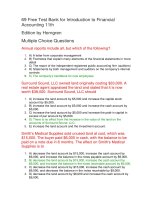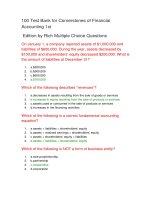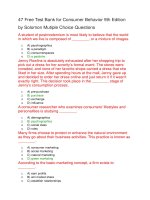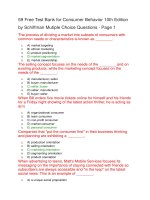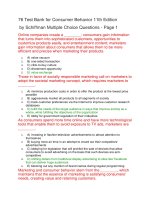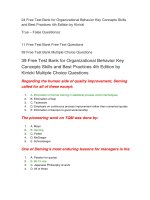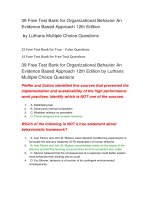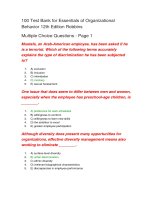145 test bank for organizational behavior 12th edition schermerhorn đề thi trắc nghiệm
Bạn đang xem bản rút gọn của tài liệu. Xem và tải ngay bản đầy đủ của tài liệu tại đây (157.4 KB, 26 trang )
145 Test Bank for Organizational Behavior 12th Edition
Schermerhorn
Multiple Choice Questions - Page 1
__________ individuals use reason and intellect to deal with
problems and downplay emotions.
1.
2.
3.
4.
5.
a) Thinking-type
b) Feeling-type
c) Intuitive-type
d) Cognitive-type
e) Sensation-type
__________individuals prefer routine and order, and
emphasize well-defined details in gathering
information; they would rather work with known facts
than look for possibilities.
1.
2.
3.
4.
5.
a) Thinking-type
b) Feeling-type
c) Intuitive-type
d) Sensation-type
e) Cognitive-type
Which of the following statements about problem-solving
styles is NOT accurate?
1.
2.
a) Information gathering involves getting and organizing data for use.
b) Sensation-type individuals and intuitive-type individuals represent two forms of
information gathering.
3. c) Evaluation involves making judgments about how to deal with information once
it has been collected.
4. d) Two forms of evaluation are feeling and thinking.
5. e) Problem-solving styles are most frequently measured by the MorrisonBellarmine Type Index.
Which of the following statements about locus of control is
correct?
1.
2.
3.
a) People with an external locus of control tend to be more introverted.
b) People with an internal locus of control tend to be more extroverted.
c) People with an internal locus of control tend to perform better on tasks requiring
complex information processing and learning.
4. d) People with an external locus of control are more oriented toward their own
feelings.
5.
e) Many managerial and professional jobs require behavior that is consistent with
an external locus of control.
________ means being aware of the behaviors, preferences,
styles, biases, personalities, and so on of others.
1.
2.
3.
4.
5.
a) Self-awareness
b) Awareness of others
c) Self-concept
d) Self-esteem
e) Self-efficacy
__________ individuals prefer the “big picture”, like solving
new problems, dislike routine, and would rather look
for possibilities than work with facts.
1.
2.
3.
4.
5.
a) Thinking-type
b) Feeling-type
c) Intuitive-type
d) Cognitive-type
e) Sensation-type
Which of the following personality traits is NOT included in
the “Big Five”?
1.
2.
3.
4.
5.
a) Extraversion
b) Agreeableness
c) Conscientiousness
d) Self-concept
e) Emotional stability
Which of the following statements does NOT accurately
describe high self-monitors?
1.
2.
3.
4.
5.
a) High self-monitors are sensitive to external cues.
b) High self-monitors tend to behave differently in different situations.
c) High self-monitors present a very different appearance from their true self.
d) High self-monitors ignore the behavior of others.
e) High self-monitors are flexible and especially good at responding to situational
contingencies.
Individuals with a sensation-feeling style of problem solving
tend to be good at which of the following?
1.
2.
3.
4.
5.
a) Empathizing
b) Observing
c) Imagining
d) Inquiring
e) Filing
Which of the following statements provides an inaccurate
description of people with high self-esteem?
1.
2.
3.
4.
5.
a) They see themselves as capable, worthwhile, and acceptable.
b) They tend to have few doubts about themselves.
c) They seldom experience a boost in job performance.
d) When under pressure, they may become boastful and act egotistically.
e) They may be overconfident at times.
__________ traits are surface-level traits that reflect the way
a person appears to others when interacting in various
social settings.
1.
2.
3.
4.
5.
a) Standard
b) Statutory
c) Situational
d) Social
e) Demographic
Firstborns in families tend to be __________.
1.
2.
3.
4.
5.
a) loners
b) quiet
c) shy
d) impatient
e) enterprising
__________ means being aware of our own behaviors,
preferences, styles, biases, personalities, and so on.
1.
2.
3.
4.
5.
a) Self-awareness
b) Awareness of others
c) Self-concept
d) Self-esteem
e) Self-efficacy
A person high in __________ is concerned with toughness
and power and opposes the use of subjective feelings.
1.
2.
3.
4.
5.
a) authoritarianism
b) Machiavellianism
c) internal locus of control
d) dogmatism
e) external locus of control
The __________ traits measure how much an individual
experiences emotional distress or displays
unacceptable acts.
1.
a) cognitive strength
2.
3.
4.
5.
b) statutory adjustment
c) emotional adjustment
d) social desirability
e) personal conception
__________ and __________ are two related aspects of the
self-concept.
1.
2.
3.
4.
5.
a) Self-esteem; self-monitoring
b) Self-esteem; self-assessment
c) Self-esteem; self-efficacy
d) Self-monitoring; self-assessment
e) Self-monitoring; self-efficacy
Which traits are associated with the “Big Five” personality
dimension of extraversion?
1.
2.
3.
4.
5.
a) Outgoing, sociable, and assertive
b) Good-natured, trusting, and cooperative
c) Responsible, dependable, and persistent
d) Unworried, secure, and relaxed
e) Imaginative, curious, and broad-minded
A person with a(n) __________ personality regards legitimate
authority as absolute and accepts or rejects others
according to how much they agree with accepted
authority.
1.
2.
3.
4.
5.
a) dogmatic
b) authoritarian
c) external locus of control
d) Machiavellian
e) type A
__________ individuals are oriented toward conformity and
try to accommodate themselves to other people.
1.
2.
3.
4.
5.
a) Cognitive-type
b) Sensation-type
c) Intuitive-type
d) Feeling-type
e) Thinking-type
__________ combines a set of physical and mental
characteristics that reflect how a person looks, thinks,
acts, and feels.
1.
2.
a) Cognition
b) Personality
3.
4.
5.
c) Perception
d) Aptitude
e) Ability
The “Big Five” personality dimension of agreeableness
refers to which of the following sets of personality
traits?
1.
2.
3.
4.
5.
a) Outgoing, sociable, and assertive
b) Good-natured, trusting, and cooperative
c) Responsible, dependable, and persistent
d) Unworried, secure, and relaxed
e) Imaginative, curious, and broad-minded
An individual high in __________ sees the world as a
threatening place.
1.
2.
3.
4.
5.
a) self-monitoring
b) Machiavellianism
c) authoritarianism
d) locus of control
e) dogmatism
Research has shown that proactive personality is positively
related to all of the following EXCEPT:
1.
2.
3.
4.
5.
a) job performance.
b) creativity.
c) leadership.
d) salary.
e) career success.
Which of the following is LEAST likely to be observed in a
high-Mach personality?
1.
2.
3.
4.
5.
a) Capable of lying to achieve personal goals
b) Approaches situations logically
c) Rarely swayed by loyalty
d) Rarely skilled at influencing others
e) Rarely swayed by the opinions of others
Conscientiousness is a “Big Five” personality dimension
that involves the traits of being __________.
1.
2.
3.
4.
5.
a) outgoing, sociable, and assertive
b) good-natured, trusting, and cooperative
c) responsible, dependable, and persistent
d) unworried, secure, and relaxed
e) imaginative, curious, and broad-minded
Problem-solving style reflects the way a person goes about
__________ and __________ information in solving
problems and making decisions.
1.
2.
3.
4.
5.
a) interpreting; evaluating
b) interpreting; communicating
c) gathering; collecting
d) evaluating; analyzing
e) gathering; evaluating
55 Free Test Bank for Organizational Behavior 12th
Edition Schermerhorn Multiple Choice Questions Page 2
All of the following are terminal values EXCEPT:
1.
2.
3.
4.
5.
a) a sense of accomplishment.
b) a world of beauty.
c) mature love.
d) forgiving.
e) freedom.
__________ refers to policies and practices that seek to
include people within a workforce who are considered
to be, in a way, different from those in the prevailing
constituency.
1.
2.
3.
4.
5.
a) Workforce diversity
b) Cultural variance
c) Employee divergence
d) Inclusiveness
e) Employee multiculturalism
__________ is the best first-line strategy in the battle against
stress.
1.
2.
3.
4.
5.
a) Stress prevention
b) Stress avoidance
c) Personal wellness
d) EAPs
e) Stress management
Which of the following statements concerning sexual
orientation is TRUE?
1.
2.
a) Sexual orientation is protected by the EEOC.
b) The first U.S. corporation to add sexual orientation to its nondiscrimination
policy was Apple Computers.
3.
c) A 2010 Harris poll shows that 78 percent of heterosexual adults in the U.S.
agree that how an employee performs at his or her job should be the standard for
judging an employee, not one’s sexual orientation.
4. d) Few companies are extending rights to gay workers.
5. e) Attitudes towards gays in the workplace are not changing significantly.
__________ stress has a positive impact on both attitudes
and performance.
1.
2.
3.
4.
5.
a) Efficient
b) Statutory
c) Natural
d) Constructive
e) Affluent
Which of the following is NOT one of the “work setting”
values specifically identified by Meglino and
associates?
1.
2.
3.
4.
5.
a) Achievement
b) Economic values
c) Helping and concern for others
d) Honesty
d) Fairness
Baby Boomers believe that Millenials __________.
1.
2.
3.
4.
5.
a) are very hard working
b) are too entitled
c) are earning their stripes quickly
d) value structure
e) value professional dress
All of the following are instrumental values EXCEPT:
1.
2.
3.
4.
5.
a) self-control.
b) self-respect.
c) honesty.
d) ambition.
e) imagination.
Which of the following statements is TRUE concerning
dimensions of national culture?
1.
2.
3.
4.
5.
a) U.S. is a more long-term oriented country
b) Japan’s culture is considered to be feminine
c) U.S. has a highly individualistic culture
d) Hong Kong is considered to have a high uncertainty avoidance culture
e). Mexico is considered to have an individualistic culture
When learning to say no, an individual should do which of
the following?
1.
2.
3.
4.
5.
a) Focus on what matters most
b) Weigh the yes-to-stress ratio
c) Take guilt out of the equation
d) Sleep on it
e) All of the above
Which of the following has been cited as a recommendation
for changing structures and perceptions to address
the leaking pipeline?
1.
2.
3.
4.
5.
a) Provide mentoring for all high potential female managers
b) Create organizational cultures more satisfying to women
c) Measure performance through results
d) Actively monitor satisfaction levels of women
e) All of the above
When people lose interest in and satisfaction with a job due
to stressful working conditions, they are likely to
experience __________.
1.
2.
3.
4.
5.
a) constructive stress
b) Type A behavior
c) job burnout
d) Type B behavior
e) eustress
Which of the following is NOT an example of instrumental
values?
1.
2.
3.
4.
5.
a) Courage
b) Love
c) Wisdom
d) Logic
e) Independence
Which of the following is an incorrect description of the
workplace values schema developed by Bruce Meglino
and his associates?
1.
2.
3.
4.
5.
a) Getting things done and working hard to accomplish difficult things in life
b) Being concerned for other people and helping others
c) Telling the truth and doing what you feel is right
d) Discovering truth through reasoning and systematic thinking
e) Being impartial and doing what is fair for all concerned
Managers should be alert to key symptoms of excessive
stress in themselves and their employees. Which of
the following is a key stress symptom?
1.
2.
3.
4.
5.
a) Changes from punctuality to tardiness
b) Changes from diligent work to careless work
c) Changes from a positive attitude to a negative attitude
d) Changes from cooperation to hostility
e) All of the above
Peoples’ __________ develop as a product of the learning
and experience they encounter in the cultural setting
in which they live.
1.
2.
3.
4.
5.
a) wants
b) needs
c) perceptions
d) cognitions
e) values
__________ in organizations emphasizes appreciation of
differences in creating a setting where everyone feels
valued and accepted.
1.
2.
3.
4.
5.
a) Employee appreciation
b) Valuing diversity
c) Diversity divergence
d) Employee valuation
e) Employee tolerance
__________ involves the pursuit of one’s job and career
goals with the support of a personal health promotion
program.
1.
2.
3.
4.
5.
a) Quality of work life programs
b) Stress prevention programs
c) Eustress management programs
d) Employee assistance programs
e) Personal wellness
__________ occurs when individuals express positive
feelings upon encountering others who exhibit values
similar to their own.
1.
2.
3.
4.
a) Personal consistency
b) Theoretical consistency
c) Personal congruence
d) Value performance
5.
e) Value congruence
Estimates indicate that __________ Americans have one or
more physical or mental disabilities.
1.
2.
3.
4.
5.
a) 10 million
b) 20 million
c) 30 million
d) 40 million
e) 50 million
Common work-related stressors include all of the following
EXCEPT:
1.
2.
3.
4.
5.
a) ethical dilemmas.
b) interpersonal problems.
c) economic difficulties.
d) career development problems.
e) task demands.
Which of the following is an example of a problem-focused
coping strategy?
1.
2.
3.
4.
5.
a) Look for the silver lining
b) Try to look on the bright side
c) Stand your ground and fight for what you want
d) Try to forget the whole thing
e) Accept sympathy from someone
What phrase was coined to describe how women have not
reached the highest levels of organizations?
1.
2.
3.
4.
5.
a) Multiculturalism
b) Inclusivity
c) Leaking pipeline
d) Reverse discrimination
e) Double bind
Title VII covers all of the following issues EXCEPT:
1.
2.
3.
4.
5.
a) recruiting.
b) promotion.
c) job training.
d) union membership.
e) wages.
__________, also known as distress, is dysfunctional.
1.
2.
3.
a) Job burnout
b) Eustress
c) Constructive stress
4.
5.
d) Abnormal stress
e) Destructive stress
Which of the following is NOT a common work-related
stressor?
1.
2.
3.
4.
5.
a) Being asked to do too much
b) Being asked to do too little
c) Not knowing what you are expected to do
d) The birth of a child
e) Being bothered by noise and lack of privacy
Which of the following is NOT an example of a terminal
value?
1.
2.
3.
4.
5.
a) Broad-mindedness
b) An exciting life
c) A world at peace
d) Family security
e) Pleasure
Which of the following statements does NOT describe the
Type A personality?
1.
2.
3.
4.
5.
a) Type A people tend to work fast
b) Type A people tend to be abrupt
c) Type A people tend to be laid back
d) Type A people tend to be irritable
e) Type A people tend to be aggressive
In recent years, the workplace has experienced a shift from a
focus on diversity to a focus on __________.
1.
2.
3.
4.
5.
a) multiculturalism
b) inclusion
c) social identity
d) affirmative action
e) EEO
True - False Questions - Page 1
The “Big Five” personality traits include extraversion,
agreeableness, conscientiousness, emotional stability,
and creativity.
1.
2.
True
False
In assessing a person’s problem-solving style, information
gathering involves making judgments about how to
deal with and interpret information.
1.
2.
True
False
Individuals with a Type A orientation are characterized as
being more easy going and less competitive than Type
B.
1.
2.
True
False
High self-monitoring individuals cannot disguise their
behaviors ¾ “what you see is what you get.”
1.
2.
True
False
Problem-solving style is a measure representing social
traits.
1.
2.
True
False
Positive and innovative changes in organizations have a
greater degree of positive effects on proactive
individuals.
1.
2.
True
False
A low-Machiavellian personality approaches situations
logically and thoughtfully and is even capable of lying
to achieve personal goals.
1.
2.
True
False
Individuals with a Type B orientation are characterized by
impatience, desire for achievement, and
perfectionism.
1.
2.
True
False
Personality represents the overall combination of
characteristics that capture the unique nature of a
person as he or she reacts and interacts with others.
1.
2.
True
False
Problem-solving styles are most frequently measured by the
Myers-Briggs Type Indicator (MBTI), which asks
individuals how they usually act or feel in specific
situations.
1.
2.
True
False
Personal conception traits represent the way individuals
tend to think about their social and physical setting as
well as their major beliefs and personal orientation
concerning a range of issues.
1.
2.
True
False
Stress is a state of tension experienced by individuals facing
extraordinary demands, constraints, or opportunities.
1.
2.
True
False
People with an internal locus of control exhibit greater selfcontrol, are more cautious, engage in less risky
behavior, and are less anxious.
1.
2.
True
False
In terms of job performance, research has shown that
conscientiousness predicts job performance across
five occupational groups of professions—engineers,
police, managers, salespersons, and skilled and
semiskilled employees.
1.
2.
True
False
People with an intuitive-thinking style of problem solving
tend to be speculative, objective, impersonal, and
idealistic.
1.
2.
True
False
Highly authoritarian individuals are so susceptible to
authority that in their eagerness to comply they may
behave unethically.
1.
2.
True
False
According to research by Rich Arvey and colleagues, family
experiences are more important than experiences at
work in shaping women’s leadership development.
1.
2.
True
False
As a determinant of personality, heredity consists of those
factors that are determined at conception, including
physical characteristics, gender, and personality
factors.
1.
2.
True
False
In OB, the term individual differences is used to refer to the
ways in which people are similar and how they vary in
their thinking, feeling, and behavior.
1.
2.
True
False
People with an external locus of control believe that they
control their own fate or destiny.
1.
2.
True
False
Extraversion, a “Big Five” personality dimension, is
associated with being imaginative, curious, and broadminded.
1.
2.
True
False
A person high in dogmatism tends to adhere rigidly to
conventional values and to obey recognized authority.
1.
2.
True
False
Self-esteem has no drawbacks; high self-esteem only boosts
performance and satisfaction.
1.
2.
True
False
Thinking-type individuals use reason and intellect to deal
with problems and they downplay emotions.
1.
2.
True
False
Environment sets the limits on just how much an individual’s
personality characteristics can be developed; heredity
determines development within these limits.
1.
2.
True
False
In studying individual differences, we attempt to identify
where behavioral tendencies are similar and where
they are different.
1.
2.
True
False
Self-esteem is an individual’s belief about the likelihood of
success in completing a particular task.
1.
2.
True
False
In solving problems, sensation-type individuals prefer
routine and order whereas intuitive-type individuals
prefer the “big picture.”
1.
2.
True
False
59 Free Test Bank for Organizational Behavior 12th
Edition Schermerhorn True - False Questions Page 2
Personal wellness requires attention to such factors as
smoking, weight, diet, alcohol use, and physical
fitness.
1.
2.
True
False
In the workplace, sexual orientation and ablebodiedness are
protected from discrimination by Title VII of the Civil
Rights Act of 1964.
1.
2.
True
False
The primary generational point of conflict is work ethic.
1.
2.
True
False
Even though recent studies report that there is no significant
difference in performance between workers with
disabilities and those without, nearly three quarters of
people with severe disabilities are reported to be
unemployed.
1.
2.
True
False
In Meglino’s value schema, the value of honesty refers to
being impartial and doing what is fair for all
concerned.
1.
2.
True
False
Sexual orientation is protected by the EEOC.
1.
True
2.
False
People are born into a society that teaches their members its
culture.
1.
2.
True
False
Research shows that companies with a higher percentage of
female board directors and corporate officers, on
average, financially outperform companies with the
lowest percentages by significant margins.
1.
2.
True
False
Values are broad preferences concerning appropriate
courses of action or outcomes.
1.
2.
True
False
Eustress has a negative impact on both attitudes and
performance.
1.
2.
True
False
Value congruence occurs when individuals express positive
feelings upon encountering others who exhibit values
similar to their own.
1.
2.
True
False
High power distance and collectivism are often found
together, as are low power distance and individualism.
1.
2.
True
False
In recent years, there has been a shift from a focus on
diversity to a focus on inclusion.
1.
2.
True
False
Meglino’s value schema includes theoretical, economic,
aesthetic, social, political, and religious values.
1.
2.
True
False
When using the Hofstede framework of national culture, it is
important to remember that the five dimensions are
independent.
1.
2.
True
False
In Hofstede’s framework of national culture, individualismcollectivism reflects the degree to which organizations
emphasize competition and assertiveness versus
interpersonal sensitivity and concerns for
relationships.
1.
2.
True
False
The way individuals think about such matters as
achievement, material gain, wealth, risk and change
may influence how they approach work and their
relationships with organizations.
1.
2.
True
False
To make a plan of action and follow it is an example of an
emotion-focused coping strategy.
1.
2.
True
False
Job burnout manifests itself as a loss of interest in and
satisfaction with a job due to stressful working
conditions.
1.
2.
True
False
Culture is the learned, shared way of doing things in a
particular society.
1.
2.
True
False
The leaking pipeline describes how women have not reached
the highest levels of organizations.
1.
2.
True
False
When values differ, or are incongruent, conflicts over such
things as goals and the means to achieve them may
result.
1.
2.
True
False
Workforce diversity has increased in the U.S. and decreased
in the rest of the world.
1.
2.
True
False
Bruce Meglino’s classification of human values includes the
values of achievement, helping and concern for others,
honesty, and fairness.
1.
2.
True
False
Both terminal and instrumental values differ across groups,
and these differences can encourage conflict or
agreement when the groups have to deal with each
other.
1.
2.
True
False
According to Hofstede’s framework of national culture,
uncertainty avoidance reflects the degree to which
people are likely to respect hierarchy and rank in
organizations.
1.
2.
True
False
According to Hofstede’s framework, value differences across
national cultures can be evaluated in terms of power
distance, uncertainty avoidance, individualismcollectivism, masculinity-femininity, and longterm/short-term orientation.
1.
2.
True
False
Valuing diversity assumes that groups will retain their own
characteristics.
1.
2.
True
False
When examining value congruence between leaders and
followers, researchers using Meglino’s value schema
reported greater follower satisfaction with a leader
when there was value congruence in terms of
achievement, helping, honesty and fairness values.
1.
2.
True
False
Values rarely influence an individual’s attitudes and
behaviors.
1.
2.
True
False
South Korea is low on Hofstede’s long-term orientation and
the U.S. is a more long-term oriented country.
1.
2.
True
False
Free Text Questions
Individuals with a(n) __________ orientation are
characterized by impatience, desire for achievement,
and perfectionism.
Answer Given
Type A
__________ is a phrase coined to describe how women have
not reached the highest levels of organizations.
Answer Given
Leaking pipeline
The five dimensions of national culture identified by Geert
Hofstede are __________, __________, __________,
__________, and __________.
Answer Given
power distance; uncertainty avoidance; individualism-collectivism; masculinityfemininity; long-term/short-term orientation
__________ refer to the wide variety of things that cause
stress for individuals.
Answer Given
Stressors
__________ represent the way individuals tend to think about
their social and physical settings as well as their major
beliefs and personal orientation concerning a range of
issues.
Answer Given
Personal conception traits
What are two related aspects of the self-concept?
Answer Given
Self-esteem and self-efficacy
Carl Jung’s work on problem-solving style reflects the way a
person __________ and __________ information.
Answer Given
gathers; evaluates
Discuss the types of diversity reflected in the workplace
today and how organizations can value and support
diversity.
Answer Given
Diversity can be considered from many perspectives, including demographic
(gender, race/ethnicity, age), disability, economic, religion, sexual orientation,
marital status, parental status, etc. Organizations can commit to the creation of
environments that welcome and embrace inclusion. This might include a strong
commitment to inclusion for the board and top management, providing influential
mentors to provide guidance, providing opportunities for networking with influential
colleagues, providing role models, exposing diverse populations through high
visibility assignments, building an inclusive culture that values differences, and
working to acknowledge and reduce subtle stereotypes and stigmas.
People who believe that the events in their lives are
controlled primarily by themselves are said to have
a(n) __________ locus of control.
Answer Given
internal
Identify and define the five dimensions that Geert Hofstede
uses to describe differences in national cultures.
Describe the implications of each dimension for
organizations and their members. Also provide
examples of countries that fall at opposite ends of
Hofstede’s dimensions.
Answer Given
Hofstede’s five dimensions of national culture are: (a) power distance –– the
willingness of a culture to accept status and power differences among its
members, (b) uncertainty avoidance –– a cultural tendency toward discomfort with
risk and ambiguity; (c) individualism-collectivism –– the tendency of a culture to
emphasize individual or group interests; (d) masculinity-femininity –– the tendency
of a culture to value stereotypical masculine or feminine traits; and (e) longterm/short-term orientation –– the tendency of a culture to emphasize values
associated with the future, such as thrift and persistence, or values that focus
largely on the present. The implications of each dimension for organizations and
their members are: (a) power distance –– reflects the degree to which people are
likely to respect hierarchy and rank in organizations, (b) uncertainty avoidance ––
reflects the degree to which people prefer structured versus unstructured
organizational situations; (c) individualism-collectivism –– reflects the degree to
which people prefer working as individuals or working together in groups; (d)
masculinity-femininity –– reflects the degree to which organizations emphasize
competition and assertiveness versus interpersonal sensitivity and concern for
relationships; and (e) long-term/short-term orientation –– reflects the degree to
which people and organizations adopt long-term or short-term performance
horizons. Examples of countries that are opposites on each dimension are: (a)
power distance –– Sweden is a relatively low power distance culture and
Indonesia is a high power distance culture ; (b) uncertainty avoidance –– Hong
Kong is a low uncertainty avoidance culture and France is a high uncertainty
avoidance culture; (c) individualism-collectivism –– the United States is an
individualistic culture and Mexico is a more collectivist culture; (d) masculinityfemininity –– Japan is a masculine culture and Thailand is a more feminine
culture; and (e) long-term/short-term orientation –– South Korea has a long-term
orientation and the United States is oriented more toward the short term.
__________ diversity is a result of Millenials, Gen Xers, and
Baby Boomers in the workplace.
Answer Given
Generational
__________ prohibits employers from discriminating against
any individual with respect to compensation, terms, or
conditions of employment because of race, color,
religion, sex, or national origin.
Answer Given
Title VII of the Civil Rights Act of 1964
Differentiate between constructive stress and destructive
stress. Discuss coping mechanisms.
Answer Given
Stress is a state of tension experienced by individuals facing extraordinary
demands, constraints, or opportunities. Constructive stress, or eustress, acts in a
positive way for the individual and the organization. Moderate levels of stress are
constructive. Destructive stress, or distress is dysfunctional for both the individual
and the organization. Too little or too much stress can be destructive, but the
emphasis is most commonly placed on the effects of too much stress. The two
major coping mechanisms are those which regulate emotions (emotion-focused
coping) and those which manage the problem that is causing the distress
(problem-focused coping).
According to Hofstede’s national culture framework,
__________ reflects the degree to which organizations
emphasize competition and assertiveness versus
interpersonal sensitivity and concerns for
relationships.
Answer Given
masculinity-femininity
__________ means being aware of our own behaviors,
preferences, styles, biases, personalities, and so on.
Answer Given
Self-awareness
Explain Rokeach’s categories of values and provide
examples of each.
Answer Given
Michael Rokeach classified values into two categories – terminal and instrumental.
Terminal values reflect a person’s preferences concerning the ends to be
achieved. They are the goals an individual would like to achieve during his or her
lifetime. Examples of terminal values are a comfortable life, wisdom, mature love,
and happiness. Instrumental values reflect the means for achieving desired ends.
They represent how you might go about achieving your important end states,
depending on the relative importance you attach to the instrumental values.
Examples of instrumental values are ambitious, broad-mindedness, responsible,
and self-control.
__________ reflect a person’s preferences concerning the
“ends” to be achieved.
Answer Given
Terminal values
__________ is a tension experienced by individuals facing
extraordinary demands, constraints, or opportunities.
Answer Given
Stress
A(n) __________ results when forces in an individual’s
personal life affect them at work.
Answer Given
spillover effect
A(n) __________ is a phenomenon whereby an individual is
rejected as a result of an attribute that is deeply
discredited by his or her society.
Answer Given
stigma
In Hofstede’s national culture framework, __________
reflects the degree to which people are likely to prefer
structured versus unstructured organizational
situations.
Answer Given
uncertainty avoidance
__________ reflects a person’s ability to adjust his or her
behavior to external, situational (environmental)
factors.
Answer Given
Self-monitoring
__________ is the learned, shared way of doing things in a
particular society.
Answer Given
Culture
__________ refers to the tendency to adhere rigidly to
conventional values and to obey recognized authority.
Answer Given
Authoritarianism
Define and provide examples for each of the following: social
traits, personal conception traits, and emotional
adjustment traits.
Answer Given
Social traits are surface-level traits that reflect the way a person appears to others
when interacting in various social settings. Problem-solving style is a prominent
example of a social trait. Personal conception traits represent the ways individuals
tend to think about their physical and social settings as well as their major beliefs
and personal orientation concerning a range of issues. Locus of control, proactive
personality, authoritarianism/dogmatism, Machiavellianism, and self-monitoring
are common personal conception traits. Emotional adjustment traits measure how
much an individual experiences emotional distress or displays unacceptable acts.
Type A and Type B personality orientations are common examples of emotional
adjustment traits.
__________ are broad preferences concerning appropriate
courses of action or outcomes.
Answer Given

